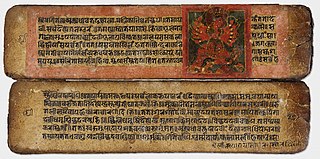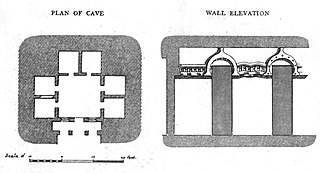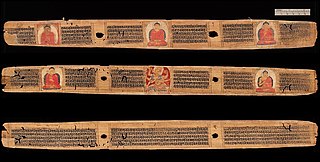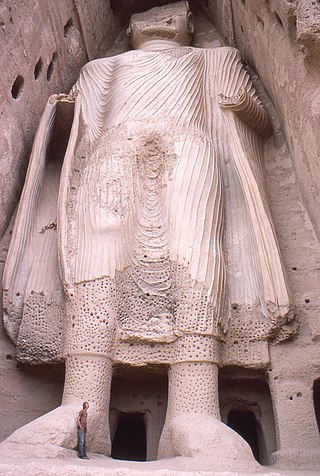Related Research Articles

The Prakrits are a group of vernacular Middle Indo-Aryan languages that were used in the Indian subcontinent from around the 3rd century BCE to the 8th century CE. The term Prakrit is usually applied to the middle period of Middle Indo-Aryan languages, excluding earlier inscriptions and the later Pali.

Sanskrit is a classical language belonging to the Indo-Aryan branch of the Indo-European languages. It arose in South Asia after its predecessor languages had diffused there from the northwest in the late Bronze Age. Sanskrit is the sacred language of Hinduism, the language of classical Hindu philosophy, and of historical texts of Buddhism and Jainism. It was a link language in ancient and medieval South Asia, and upon transmission of Hindu and Buddhist culture to Southeast Asia, East Asia and Central Asia in the early medieval era, it became a language of religion and high culture, and of the political elites in some of these regions. As a result, Sanskrit had a lasting impact on the languages of South Asia, Southeast Asia and East Asia, especially in their formal and learned vocabularies.

Mount Meru, also known as Sumeru, Sineru or Mahāmeru, is the sacred five-peaked mountain of Hindu, Jain, and Buddhist cosmology and is considered to be the centre of all the physical, metaphysical and spiritual universes. There is no clear identification of Mount Meru with a particular geophysical location.

Nalanda was a renowned mahavihara in ancient Magadha, India. Considered by historians to be the world's first residential university and among the greatest centers of learning in the ancient world, it was located near the city of Rajagriha and about 90 kilometres (56 mi) southeast of Pataliputra. Operating from 427 until 1197 CE, Nalanda played a vital role in promoting the patronage of arts and academics during the 5th and 6th century CE, a period that has since been described as the "Golden Age of India" by scholars.

Gandhāra was an ancient region located in the present-day north-west Pakistan and parts of south-east Afghanistan, roughly at the outskirts of northwestern Indian subcontinent. The region centered around the Peshawar valley and Swat valley, though the cultural influence of "Greater Gandhara" extended across the Indus river to the Taxila region in Potohar Plateau and westwards into the Kabul valley in Afghanistan, and northwards up to the Karakoram range.

Sanskrit literature broadly comprises all literature in the Sanskrit language. This includes texts composed in the earliest attested descendant of the Proto-Indo-Aryan language known as Vedic Sanskrit, texts in Classical Sanskrit as well as some mixed and non-standard forms of Sanskrit. Literature in the older language begins with the composition of the Ṛg·veda between about 1500 and 1000 BCE, followed by other Vedic works right up to the time of the grammarian Pāṇini around 6th or 4th century BCE.

The Gandhāran Buddhist texts are the oldest Buddhist manuscripts yet discovered, dating from about the 1st century BCE to 3rd century CE. They represent the literature of Gandharan Buddhism from present-day northwestern Pakistan and eastern Afghanistan, and are written in Gāndhārī.
Gāndhārī is the modern name, coined by scholar Harold Walter Bailey, for a Prakrit language found mainly in texts dated between the 3rd century BCE and 4th century CE in the region of Gandhāra, located in the northwestern Indian subcontinent. The language was heavily used by the former Buddhist cultures of Central Asia and has been found as far away as eastern China, in inscriptions at Luoyang and Anyang.

Vihāra generally refers to a Buddhist monastery for Buddhist renunciates, mostly in the Indian subcontinent. The concept is ancient and in early Sanskrit and Pali texts, it meant any arrangement of space or facilities for dwellings. The term evolved into an architectural concept wherein it refers to living quarters for monks with an open shared space or courtyard, particularly in Buddhism. The term is also found in Ajivika, Hindu and Jain monastic literature, usually referring to temporary refuge for wandering monks or nuns during the annual Indian monsoons. In modern Jainism, the monks continue to wander from town to town except during the rainy season (Chaturmas), and the term "vihara" refers to their wanderings.

Birch bark manuscripts are documents written on pieces of the inner layer of birch bark, which was commonly used for writing before the advent of mass production of paper. Evidence of birch bark for writing goes back many centuries and in various cultures.
Āstika and nāstika are concepts that have been used to classify Indian philosophies by modern scholars, as well as some Hindu, Buddhist and Jain texts. The various definitions for āstika and nāstika philosophies have been disputed since ancient times, and there is no consensus. In current Indian languages like Telugu, Hindi and Bengali, āstika and its derivatives usually mean 'theist', and nāstika and its derivatives denote an 'atheist'; however, the two terms in ancient- and medieval-era Sanskrit literature do not refer to 'theism' or 'atheism'. The terms are used differently in Hindu philosophy. For example, Sāṃkhya is both a non-theistic and āstika (Vedic) philosophy, though “God” is often used as an epithet for consciousness (purusha) within its doctrine. Similarly, though Buddhism is considered to be nāstika, Gautama Buddha is considered an avatar of Vishnu in some Hindu traditions.

Dharanis, also known as Parittas, are Buddhist chants, mnemonic codes, incantations, or recitations, usually the mantras consisting of Sanskrit or Pali phrases. Believed to be protective and with powers to generate merit for the Buddhist devotee, they constitute a major part of historic Buddhist literature. Many of these chants are in Sanskrit and Pali, written in scripts such as Siddhaṃ as well as transliterated into Chinese, Korean, Japanese, Sinhala, Thai and other regional scripts. They are similar to and reflect a continuity of the Vedic chants and mantras.

Shravasti is a town in Shravasti district in Indian State of Uttar Pradesh. It was the capital of the ancient Indian kingdom of Kosala and the place where the Buddha lived most after his enlightenment. It is near the Rapti river in the northeastern part of Uttar Pradesh India, close to the Nepalese border.

Buddhism, an Indian religion founded by Gautama Buddha, first arrived in modern-day Afghanistan through the conquests of Ashoka, the third emperor of the Maurya Empire. Among the earliest notable sites of Buddhist influence in the country is a bilingual mountainside inscription in Greek and Aramaic that dates back to 260 BCE and was found on the rocky outcrop of Chil Zena near Kandahar.

The dharmachakra or wheel of dharma is a widespread symbol used in Indian religions such as Hinduism, Jainism, and especially Buddhism.

Tipiṭaka or Tripiṭaka or තිපිටක, meaning "Triple Basket", is the traditional term for ancient collections of Buddhist sacred scriptures.
Early Buddhist texts (EBTs), early Buddhist literature or early Buddhist discourses are parallel texts shared by the early Buddhist schools. The most widely studied EBT material are the first four Pali Nikayas, as well as the corresponding Chinese Āgamas. However, some scholars have also pointed out that some Vinaya material, like the Patimokkhas of the different Buddhist schools, as well as some material from the earliest Abhidharma texts could also be quite early.

The Spitzer Manuscript is the oldest surviving philosophical manuscript in Sanskrit, and possibly the oldest Sanskrit manuscript of any type related to Hinduism and Buddhism discovered so far. The manuscript was found in 1906 in the form of a pile of more than 1,000 palm leaf fragments in the Ming-oi, Kizil Caves, China during the third Turfan expedition headed by Albert Grünwedel. It is named after Moritz Spitzer, whose team first studied it in 1927–28.

The Weber Manuscript, also called Weber Manuscripts, is a collection of nine, possibly eleven, incomplete ancient Indian treatises written mostly in classical Sanskrit that were found buried within a Buddhist monument in northwestern China in late 19th-century. It is named after the Moravian missionary F. Weber who acquired the set from an Afghani merchant in Ladakh, and then forwarded it to the German Indologist and philologist Rudolf Hoernlé in Calcutta. The manuscripts consist of 76 page-leaves, written in Northwestern Gupta and Central Asian Nagari scripts. They were copied before the end of 7th-century, likely in the 5th-century or the 6th–century. The original texts that were copied to produce these manuscripts were likely considerably older Indian texts, at least one between 3rd-century BCE and pre-2nd-century CE. The Weber Manuscript is notable for having been written on two types of paper – Central Asian and Nepalese, attesting to the spread of paper technology outside of interior China and its use for Indian religious texts by the 5th– or 6th-century.

Chitra, also spelled as Citra, is an Indian genre of art that includes painting, sketch and any art form of delineation. The earliest mention of the term Chitra in the context of painting or picture is found in some of the ancient Sanskrit texts of Hinduism and Pali texts of Buddhism.
References
- ↑ Pratapaditya Pal (2007). "Evidence of Jainism in Afghanistan and Kashmir in Ancient Times". Bulletin of the Asia Institute. New Series. 21: 25–33.
- ↑ Charles DiSimone. "Teacher Evaluations: Jains and their Doctrines as Portrayed in (Mūla-) Sarvāstivāda Buddhist Sūtra Literature" (PDF). SOAS, United Kingdom. p. 6. Archived from the original (PDF) on 2020-12-02. Retrieved 2019-10-18.